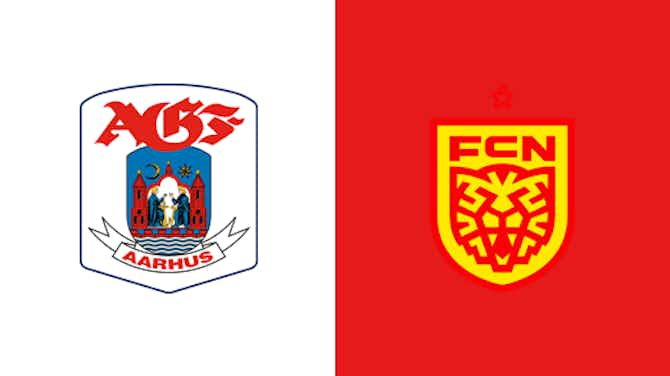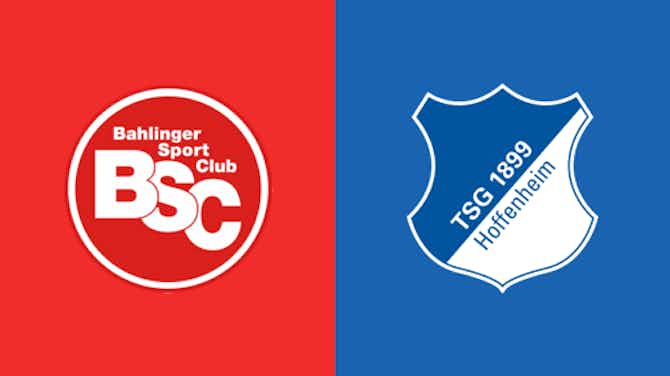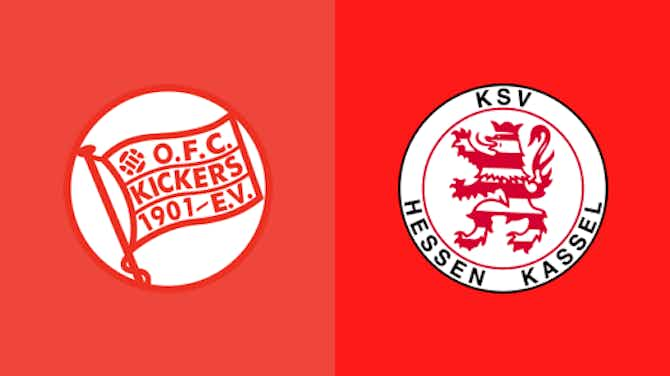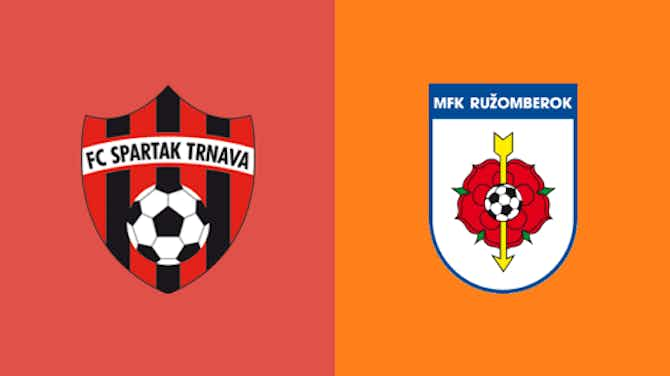Attacking Football
·19 April 2024
Can Rúben Amorim Unlock a Low Block?

Attacking Football
·19 April 2024

Liverpool have lost back-to-back games for the first time this season (in all competitions). In these fixtures, they faced Atalanta BC in the Europa League and Crystal Palace in the Premier League. These were key games for the Reds, and the two losses were significant setbacks for Jurgen Klopp. The first practically eliminating the side from Europe, and the second potentially ending their title charge.
In their last three matches, including the return leg against Atalanta, the Reds had trouble imposing their usual direct style against teams that were compact and happy to give away possession.
With these problems reoccurring for Liverpool, one has to wonder: can Rúben Amorim unlock a low block? After all, the Portuguese manager is the favourite for the job.
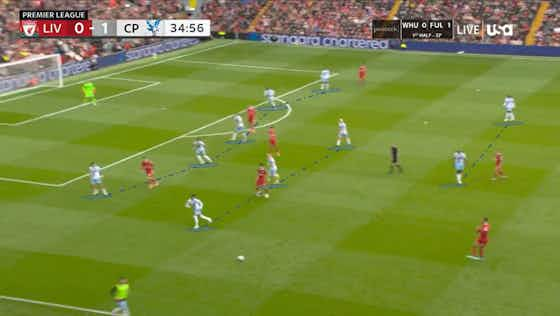
Crystal Palace Deep Block
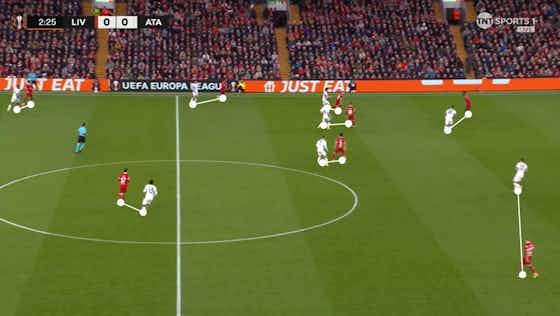
Atalanta-BC Man-to-Man Marking System
When it comes to low blocks, some call this defensive approach “old-fashioned”; others refer to it as “parking the bus.” Whatever way you want to call it, there’s no denying that this approach is regaining popularity, with many teams, including top sides, using it to their benefit.
Arsenal and Real Madrid both played in a deep block at the Etihad against Manchester City. Manchester United adopted this style earlier in the season against Liverpool at Anfield and later at Old Trafford, costing the Reds four crucial points in the league.
First off, something needs to be cleared. There’s a general misconception that Rúben Amorim’s preferred 3-4-3 formation means his team plays a defensive game with five at the back. But that’s not exactly true, especially not this season.
In 2020, when Amorim led Sporting to their first league title in 19 years, he adopted a more defensive strategy, focusing on direct attacks and set pieces. But over the past three years, he’s shifted his approach. Now, Sporting is a more aggressive team, especially when it comes to their counter-press, and they have also become a more possession-based side that is able to hit in a fast and direct manner.
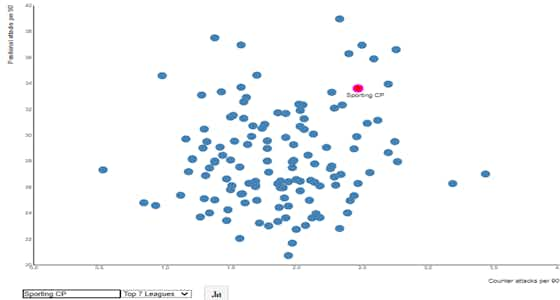
Sporting’s impressive stats, which place them first in Liga Portugal for both build-up attacks (95) and direct attacks (69), are proof of their tactical versatility. This balance highlights Amorim’s knack for mixing patient build-up play with quick, decisive strikes, making his teams tough opponents for both attacking and defensive-minded sides.

Given that Sporting’s attacking approach is somewhat similar to Liverpool’s in its directness, there are valid concerns about Amorim’s ability to dismantle the compact defences often employed by lower-ranked teams.
To gain a better understanding, let’s take a look at Sporting’s eighth match of the Portuguese league season against Arouca, a team from Porto. Why Arouca precisely? Well, this side isn’t known for playing flashy or attacking football, and it is safe to say that they aren’t the kindest on the eye either. However, what is worth noting is that they are extremely effective.
Last season under Armando Evangelista, Arouca finished fifth in the league, securing a spot in the Europa Conference League qualifiers, all with a goal difference of -1, having scored 36 goals and conceded 37. This record offers a good snapshot of Arouca’s style.
Although the club is performing worse this season under Daniel Sousa’s management (conceded 39 goals so far, two more than the previous campaign), Arouca has maintained their harsh style of play.
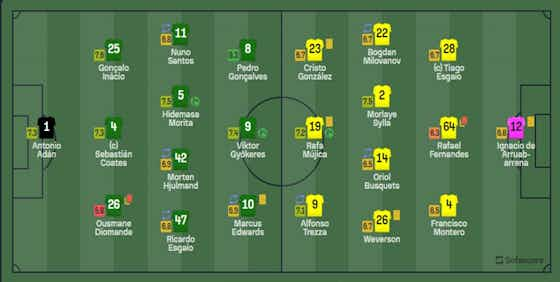
Right from the kickoff, the visitors morphed into a 5-4-1 formation out of possession, clearly aiming for a draw from the outset.
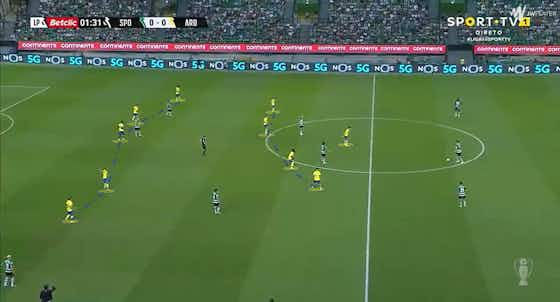
Typically, Amorim shifts to a 3-2-5 setup when his team has the ball and the opposition is dug into their own half. That’s exactly what Sporting did against Arouca.
The Sporting players started circulating the ball, progressively moving up the field. 10 outfield Sporting players were in Arouca’s half with a high defensive line; not too bad for a defensive-minded coach, right?
This high line is a key tactic in Amorim’s strategy against defensive teams.
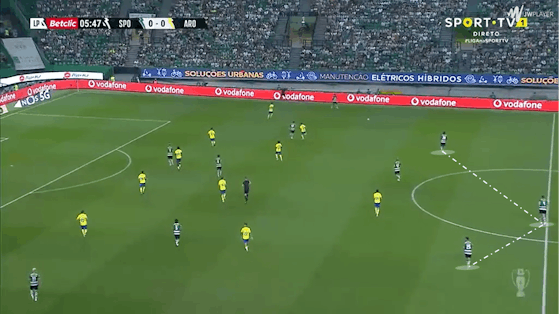
This high defensive line is crucial for effective counter-pressing; when Sporting loses the ball, having several players near the midfield allows them to quickly recover possession. This approach makes it difficult for the opposition to maintain control of the ball or advance their lines, as the reduced space between Sporting’s players shortens passing distances and accelerates their gameplay.
While Sporting’s press isn’t the most intense in the league (currently fourth with 10.9 PPDA), they are still the top club to take advantage of their high turnovers, scoring eight goals from 49 shot-ending high turnovers.
This is mainly due to how high their defensive line is, often regaining possession quickly and using it to hit in a direct manner while the opposition is still trying to get back to their shape.
The footage below is from a different game where Sporting transitioned quickly from defence to attack in seconds, thanks to their high defensive line.
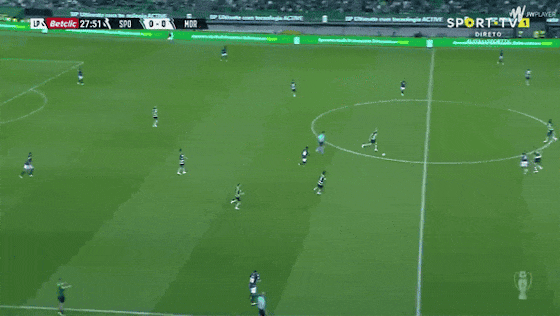
Amorim likes to keep possession, either by circulating the ball between the backline and the double pivot or by leveraging his players’ ability to progress the ball while maintaining tight control. Notice how highly ranked his three centre backs are when it comes to passing volume and carrying.
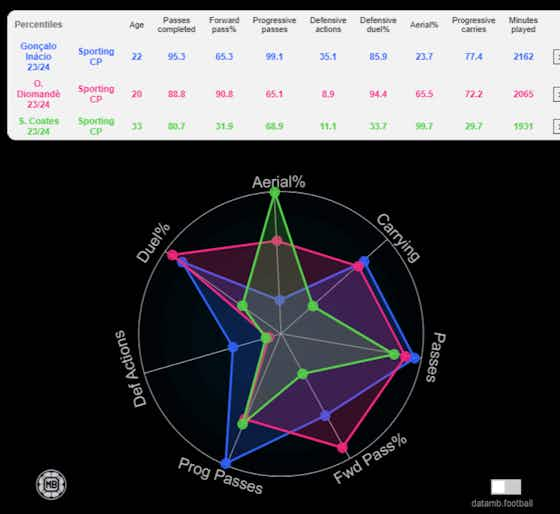
Now, when it comes to building up against low blocks, think of Sporting’s patterns like a pendulum: they swing the ball from one side to the other. This lateral movement draws opponents out, allowing Sporting to create 2v1 scenarios on the flanks with their wingbacks and central No. 10s against the opposing fullbacks.
For example, here, the right centre-back, right wing-back, and right winger kept circulating the ball on the right-hand side, all while alternating in making in-behind runs.

These continuous runs and player rotations destabilise the opponents’ defence, carving out spaces to exploit and effectively drawing and pinning their block to one side of the pitch. Consider it as a distraction.

After circulating the ball on the right-hand side, Sporting players switched the field by passing it back to Sebastián Coates at central centre-back, who then passed it to Gonçalo Inácio at left centre-back.

Pedro Gonçalves, who alternates between playing left winger and left-sided ten, dove deep into the space that Sporting had created while concentrating their play on the right side.
Now, notice how even though an Arouca player was aware of Gonçalves’ movement, he was unable to cut off the passing lane due to the large space around him and a lack of sufficient support.

With Inácio advancing with the ball, the opposing forward was compelled to close him down, effectively opening more central space for Gonçalves, who astutely drifted into position.

Observe Inácio’s body orientation—how he skillfully misleads the opposition by decoying his pass and making it look like his teammate is staying wide near the touchline when, in fact, he’s angling for a central run.
Upon receiving the ball, Gonçalves swiftly switched the play to the right side. At the same time, other central players execute sharp runs into the central and half spaces, further pinning back the defence.

This sequence is a classic example of the pendulum tactic mentioned.
Sporting focused their play on the right side of the pitch, drawing the opponents with the ball before switching to the left side. Arouca’s block theretofore, after being fixated to the right, needs to drift to the left. This is how the defending team gets distracted and becomes unaware of what is happening elsewhere because while Sporting moved the action to the left, the real intention was to open up space for the right wingback, who then found himself with ample room to manoeuvre.
This consistent pattern of play gives Sporting multiple solutions to dismantle a deep block. The players are constantly active—rotating positions, dropping deep to receive the ball, and making quick dashes into the half-spaces.
However, merely circulating the ball slowly isn’t enough against a team that lines up with five at the back. That’s why, after slowly moving the opposition from one side to the other, Sporting’s players increase the pace of their passes once they reach the final third. Think of it as a sucker punch!
This quicker tempo is crucial for breaking down well-organised defences, as it reduces their time to reset and respond to shifts in play.
The moment we’re discussing occurred after a sequence of ten consecutive passes, culminating when Inácio delivered a precise, line-breaking pass to Gonçalves.
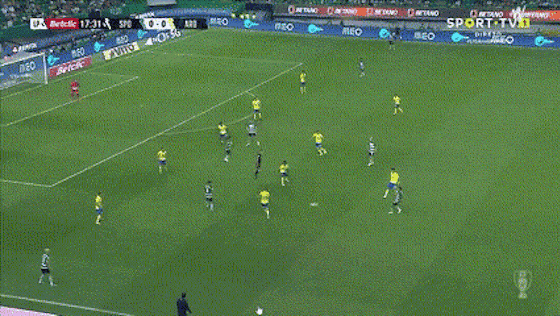
With a deft single touch, Gonçalves swiftly moved the ball to Morita, who immediately passed it to Gyokeres, already charging behind the defence. Had the ball not accidentally struck the Swede’s backheel, Sporting would have effectively pierced Arouca’s defensive line.
This way of hypnotising the opponents before striking, with players consistently moving and rotating in the frontline, was fruitful in this game as it resulted in Sporting opening the score.
The players consistently moved the ball, shifting Arouca’s defensive block from side to side, and ultimately creating a one-on-one situation for Edwards on the right side. At the same time, the varied runs from other players added layers of confusion, further destabilising Arouca’s defence.

This play unfolded through eight passes, culminating in the ninth—a precise assist from Edwards to Gyokeres, as demonstrated in the previous image.
Sporting ended the first half in control, boasting 71% possession and generating 0.89 expected goals (xG) while keeping their expected goals against (xGA) down to just 0.03.
However, the second half painted a different picture, with Amorim’s squad managing only 40% possession and their xGA increasing to 0.58. This shift was largely due to Ousmane Diomande receiving a red card in the 42nd minute, which significantly impacted Sporting’s ability to control the game as they had in the first half.
As mentioned earlier, Amorim opts for a 3-2-5 build-up structure. However, when facing a deep block and pushing higher up the pitch, Sporting transitions to a 3-1-6 during their high build-up phase.
The reason is: when the opponents strengthen their defence by adding one extra player, the attacking team must match this by adding another player upfront, creating numerical superiority. That’s precisely what the 3-1-6 setup achieves.
Amorim does this by pushing one of the holding midfielders to join the front line. Notice how high Hidemasa Morita is compared to Morten Hjulmand.

At exactly 66:55 into the match, Sporting initiated a sequence of 12 passes. Once again, they used their passes to manipulate Arouca’s formation, swinging the block from side to side just like a pendulum.
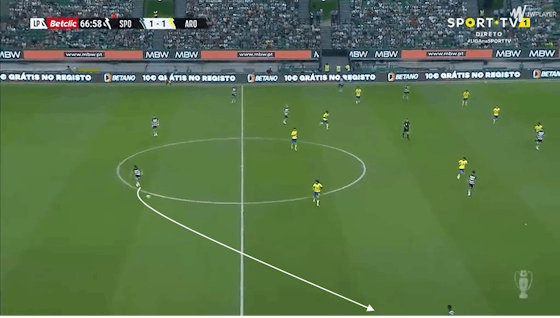
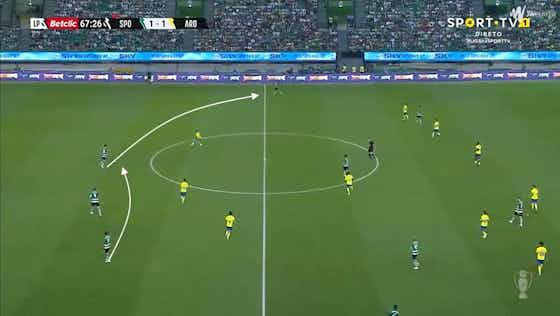
It was during this movement that Matheus Reis launched a direct pass to Gonçalves on the flank. Meanwhile, Morita, the holding midfielder, initiated his run to crash the box.

Gonçalves then made a significant impact as he entered the final third. Holding the ball well under pressure, he managed to deliver a cross that found Morita, who had made a timely run into the penalty box, giving Sporting the lead.

Whether it’s acting like a pendulum, swinging the opposition from side to side, or launching direct attacks, Amorim has consistently shown his ability to be flexible and adapt to his opponents and changing in-game scenarios. Still, there is one more weapon in the Portuguese’s arsenal.
Managers, coaches, players, and pundits often emphasise the importance of set plays, which can be a critical tool for scoring a goal when open play doesn’t yield opportunities. This is where Rúben Amorim’s side also excels this season, as they rank top of the league for most goals scored through set pieces with 16 goals.

As I watched Sporting’s goals from set pieces, I noticed a pattern that repeated itself. Whether it was a free kick or a corner, the crossing players always aim for the most dangerous part of the penalty box, which is the six yards (5.5m) between the penalty spot and the goal kick area.
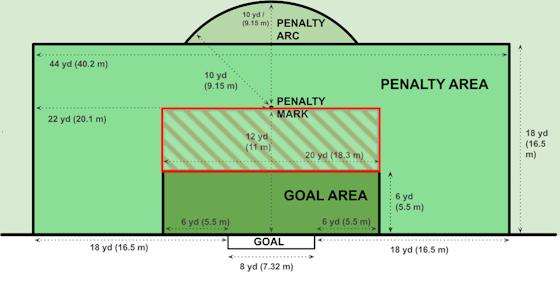
Sporting is ranked third in La Liga Portugal for aerial duals won percentage with 53.2%. Sebastián Coates is also the top player in this category, with a 79.5% aerial duals win rate.
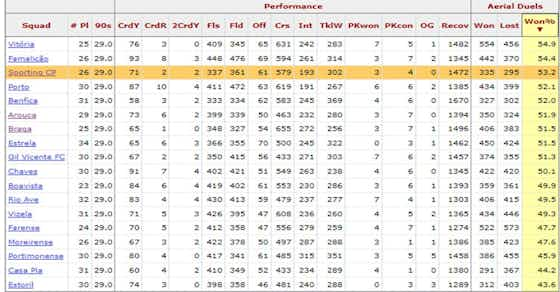
With that type of floating crosses into the mentioned area, Sporting has the second-best expected goals from set pieces with 12.77, and they are overperforming with 16 goals.

Sebastián Coates hits the post

Sebastián Coates goal

Paulinho goal

Diomande goal
However, headers are not the only type of goals Sporting scores from set plays.
Amorim likes to keep players around the box during set pieces in order to have more chances to win the second ball. This gives Sporting players the opportunity to shoot from outside the area while numerous players are blocking the keeper’s view, as well as denying the opponents the chance to counterattack.
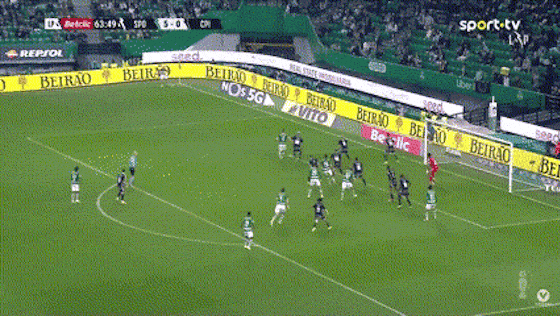
Geny Catamo Goal

Pedro Goncalves Goal
To finish it off, Amorim’s Sporting is also capable of executing smart set-piece routines in order to destabilise the opponent’s block and take them by surprise.

Francisco Trincão Goal
The simple answer is: yes!
He has a system that allows his side to create space by swinging opponents from one side to the other. He knows that you can’t beat a low block with just slow passing and instead, his side increases the pace with both its movements and passing. And, he knows how crucial set pieces are in unlocking defensive sides.
It is uncertain whether Liverpool will appoint Amorim, but if they do, they will have a manager who can adapt to opponents and in-game situations. Whether that means settling into a low block or dominating possession with continuous passing, Amorim’s teams are prepared to switch tactics as needed.
While some might view this pragmatism as overly cautious, it’s important to recognise the value of adapting to the situation to minimise risks.









